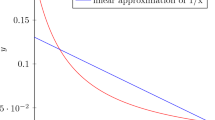Abstract
We suggest public-key cryptosystems based on groups invariants. We also give an overview of known cryptosystems that involve groups. Bibliography: 33 titles.
Similar content being viewed by others
REFERENCES
M. Ajtai and C. Dwork, “A public-key cryptosystem with worst-case/average case equivalence,” Proceedings of the 29th Annual ACM Symposium on Theory of Computing(1997), ACM, New York (1999), pp. 284–293.
I. Anshel and M. Anshel, “From the post-Markov theorem through decision problems to public-key cryptography,” Amer. Math. Monthly, 100, 835–844 (1993).
I. Anshel, M. Anshel, and D. Goldfeld, “An algebraic method for public-key cryptography,” Math. Res. Lett., 6, 287–291 (1999).
J. Benaloh, “Dense probabilistic encryption,” First Annual Workshop on Selected Areas in Cryptology(1994), pp. 120–128.
A. Blass and Y. Gurevich, “Matrix transformation is complete for the average case,” SIAM J. Comput., 24, 3–29 (1995).
D. Coppersmith and I. Shparlinski, “On polynomial approximation of the discrete logarithm and the Diffie-Hellman mapping,” J. Cryptology, 13, 339–360 (2000).
J. Dieudonn’e and J. Carrell, Invariant Theory, Old and New, Academic Press (1971).
Do Long Van, A. Jeyanthi, R. Siromony, and K. Subramanian, “Public key cryptosystems based on word problems,” ICOMIDC Symp. Math. of Computation, Ho Chi Minh City (1988).
J. Feigenbaum and M. Merritt, “Open questions, talk abstracts, and summary of discussions,” DIMACS Ser. Discrete Math. Theoret. Comput. Sci., 2, 1–45 (1991).
M. Garzon and Y. Zalcstein, “The complexity of Grigorchuk groups with application to cryptography,” Theoret. Comput. Sci., 88, 83–98 (1991).
O. Goldreich, Modern Cryptography, Probabilistic Proofs, and Pseudorandomness, Springer (1998).
O. Goldreich, S. Goldwasser, and S. Halevi, “Public-key cryptosystems from lattice reduction problems,” Lect. Notes Comput. Sci., 1294, 112–131 (1997).
S. Goldwasser and M. Bellare, Lecture Notes on Cryptography, http://www-cse.ucsd.edu/users/mihir/papers/gb.html (2001).
S. Goldwasser and S. Micali, “Probabilistic encryption,” J. Comput. System Sci., 28, 270–299 (1984).
D. Grigoriev and I. Ponomarenko, “On non-Abelian homomorphic public-key cryptosystems,” Zap. Nauchn. Semin. POMI, 293, 39–58 (2002).
K. H. Ko, S. J. Lee, J. H. Cheon, J. W. Han, J. Kang, and C. Park, “New public-key cryptosystem using braid groups,” Lect. Notes Comput. Sci., 1880, 166–183 (2000).
N. Koblitz, Algebraic Aspects of Cryptography, Springer-Verlag, Berlin (1998).
K. Koyama, U. Maurer, T. Okamoto, and S. Vanstone, “New public-key schemes based on elliptic curves over the ring ℤ n ,” Lect. Notes Comput. Sci., 576, 252–266 (1991).
L. Levin, “Average case complete problems,” SIAM J. Comput., 15, 285–286 (1986).
E. Luks, “Permutation groups and polynomial-time computations,” DIMACS Ser. Discrete Math. Theoret. Comput. Sci., 11, 139–175 (1993).
E. Luks, Personal communication(2002).
U. Maurer and S. Wolf, “Lower bounds on generic algorithms in groups,” Lect. Notes Comput. Sci., 1403, 72–84 (1998).
D. Naccache and J. Stern, “A new public-key cryptosystem,” Lect. Notes Comput. Sci., 1233, 27–36 (1997).
D. Naccache and J. Stern, “A new public-key cryptosystem based on higher residues,” Proceedings of the 5th ACM Conference on Computer and Communication Security(1998), pp. 59–66.
T. Okamoto and S. Uchiyama, “A new public-key cryptosystem as secure as factoring,” Lect. Notes Comput. Sci., 1403, 308–317 (1998).
S.-H. Paeng, D. Kwon, K.-C. Ha, and J. H. Kim, “Improved public key cryptosystem using finite non-Abelian groups,” Preprint NSRI Korea.
P. Paillier, “Public-key cryptosystem based on composite degree residuosity classes,” Lect. Notes Comput. Sci., 1592, 223–238 (1999).
D. Rappe, Algebraisch Homomorphe Kryptosysteme, Diplomarbeit, Universit¨at Dortmund (2000).
L. Ronyai, “Computations in associative algebras,” DIMACS Ser. Discrete Math. Theoret. Comput. Sci., 11, 221–243 (1993).
T. Springer, “Invariant theory,” Lect. Notes Math., 585, Springer (1977).
B. Sturmfels, Algorithms in Invariant Theory, Springer-Verlag, Vienna (1993).
N. Wagner and M. Magyarik, “A public-key cryptosystem based on the word-problem,” Lect. Notes Comput. Sci., 196, 19–36 (1985).
A. Yao, “How to generate and exchange secrets,” Proceedings of the 27th Annual IEEE Symposium on Foundations of Computer Sciences(1986), pp. 162–167.
Additional information
Translated from Zapiski Nauchnykh Seminarov POMI, Vol. 293, 2002, pp. 26–38.
Rights and permissions
About this article
Cite this article
Grigoriev, D. Public-key cryptography and invariant theory. J Math Sci 126, 1152–1157 (2005). https://doi.org/10.1007/s10958-005-0068-4
Received:
Issue Date:
DOI: https://doi.org/10.1007/s10958-005-0068-4




